A Guide to Designing Stunning Front Porch Fall Planters
The air turns crisp. Sunlight leans gold across your street. Summer greens soften. Leaves start to rustle underfoot. Your porch pauses between seasons. Pots that shouted July now whisper September. You can almost smell cinnamon and wet leaves after a light rain.
{ez-toc}
And your entry feels ready for a refresh. Not a total redo. A thoughtful shift.
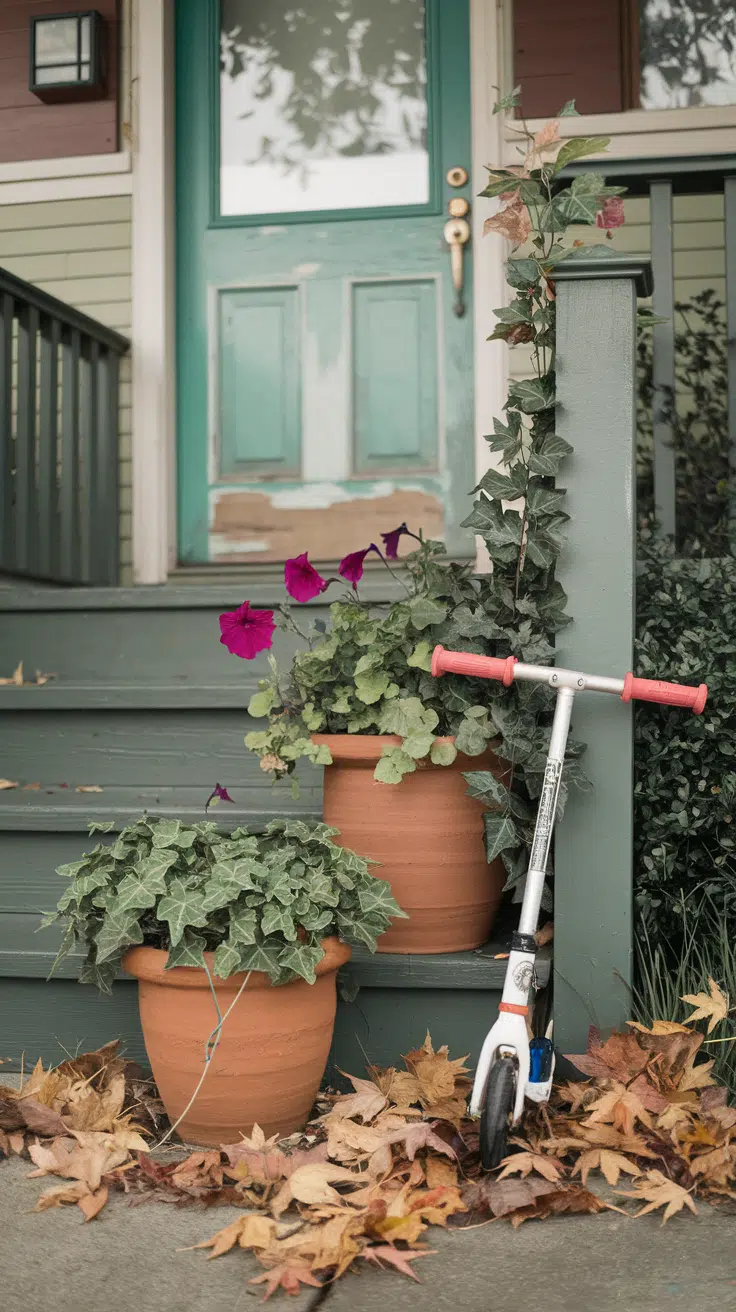
The First Whisper of Fall
Does your entrance feel like fall’s welcome? Or does it still hold onto July’s faded energy? Your door is where guests pause first. And where you greet every day. Let that small stage speak.
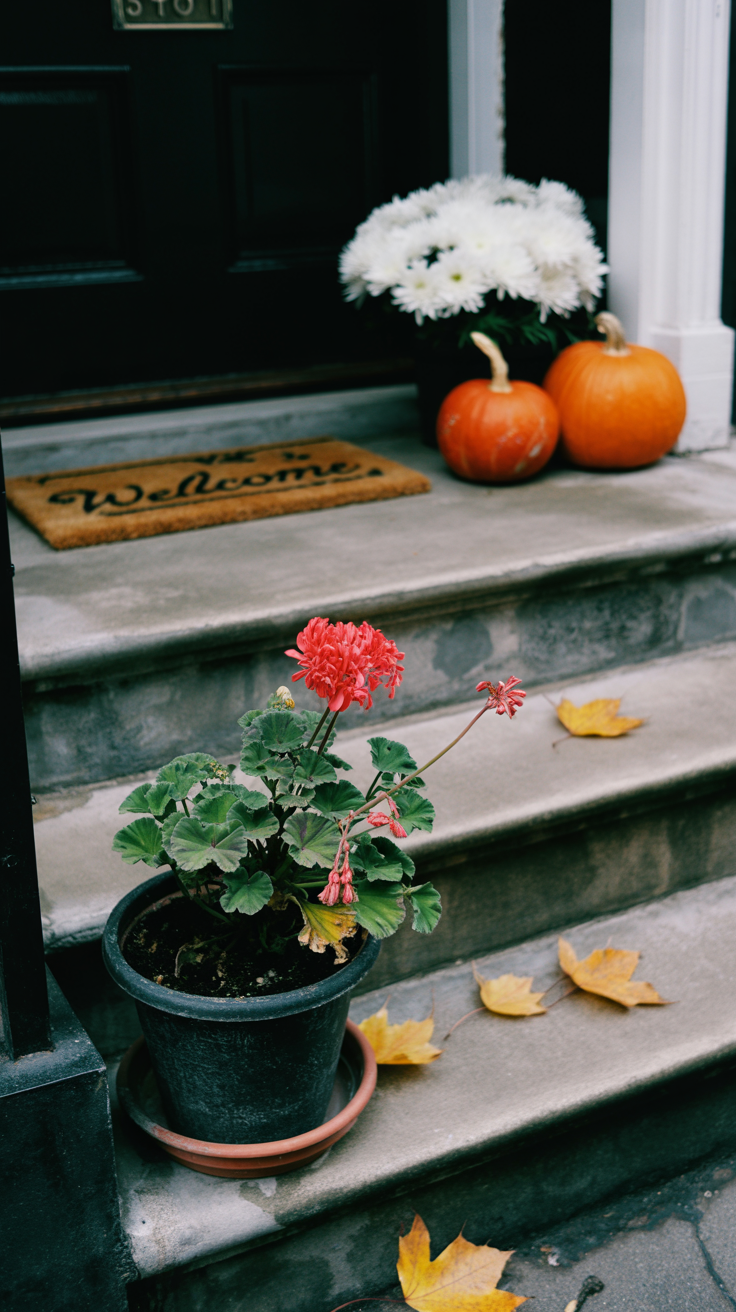
You can do more than toss a single mum at the door. You can craft emotion with plants and texture. You can turn that first step into a warm hello. And you don’t need a big budget or pro gear to get there.
We’ll shape arrangements that feel lived-in and seasonal. We’ll go past cliché ideas, using color, form, and found bits. We’ll build front porch fall planters that tell a cozy story from the very first glance.
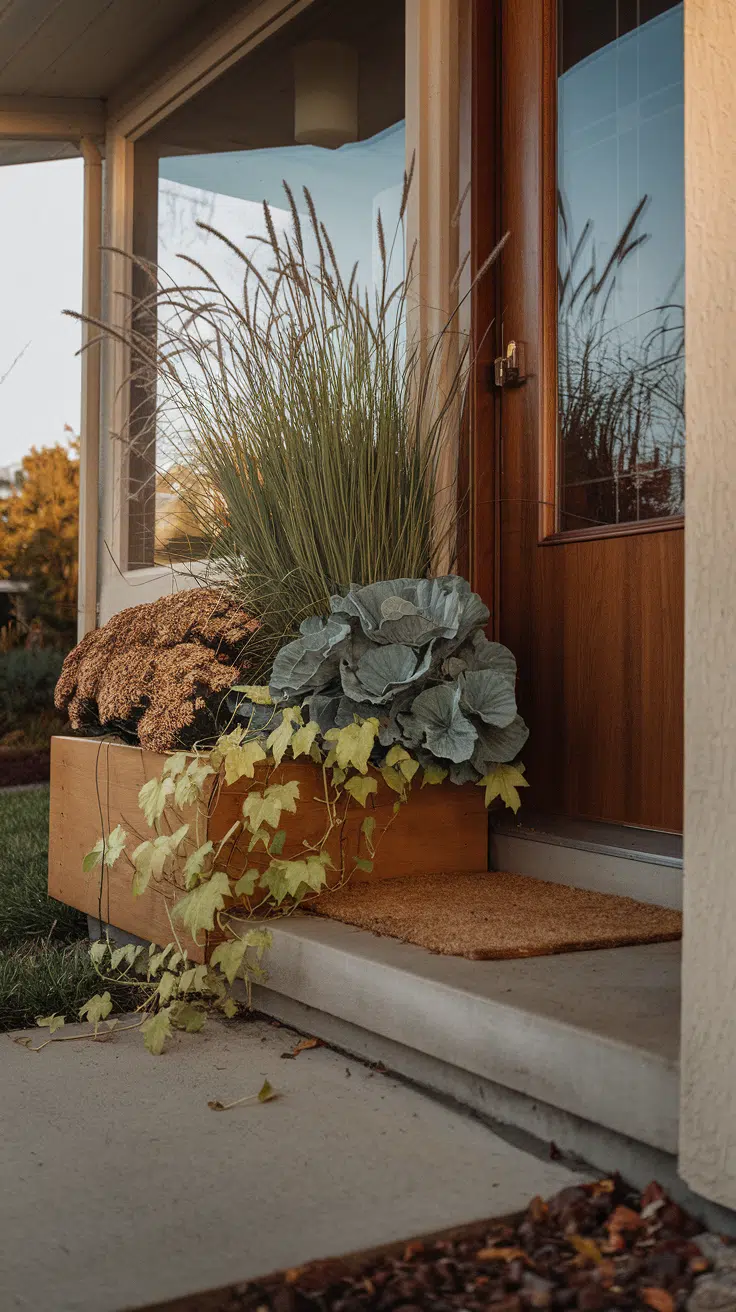
The Core Ethos — Capturing the Soul of Autumn in a Pot
Fall planter design is not just about swapping plants. It’s about mood. You’re translating a feeling into a container. Think comfort, harvest, and character. Think longer-lasting structure over quick blooms. Build with texture. Add color that feels deep and warm.
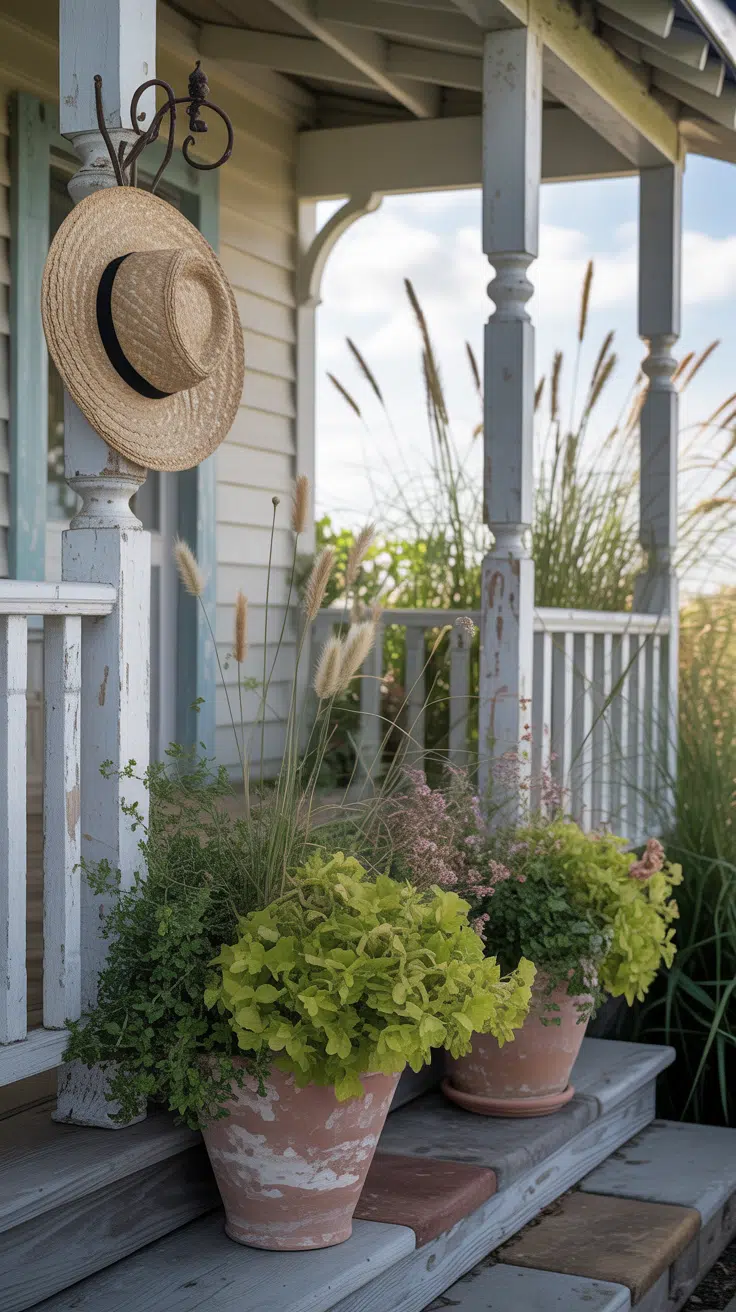
Harvest & Abundance
Fall means fullness. You want pots that feel generous and layered. Think of a cornucopia, but more modern and tidy. Use different shapes and sizes to say “plenty.” Tall grasses, mounded flowers, ruffled leaves, and small trailing plants build depth. Odd numbers usually look natural. Keep small gaps, so every plant can breathe.
You can tuck in cut stems or seed heads to boost volume. Dried millet, wheat, or broomcorn work well. A couple of mini pumpkins can nestle into soil on party weekends. Then remove them later to water easily.
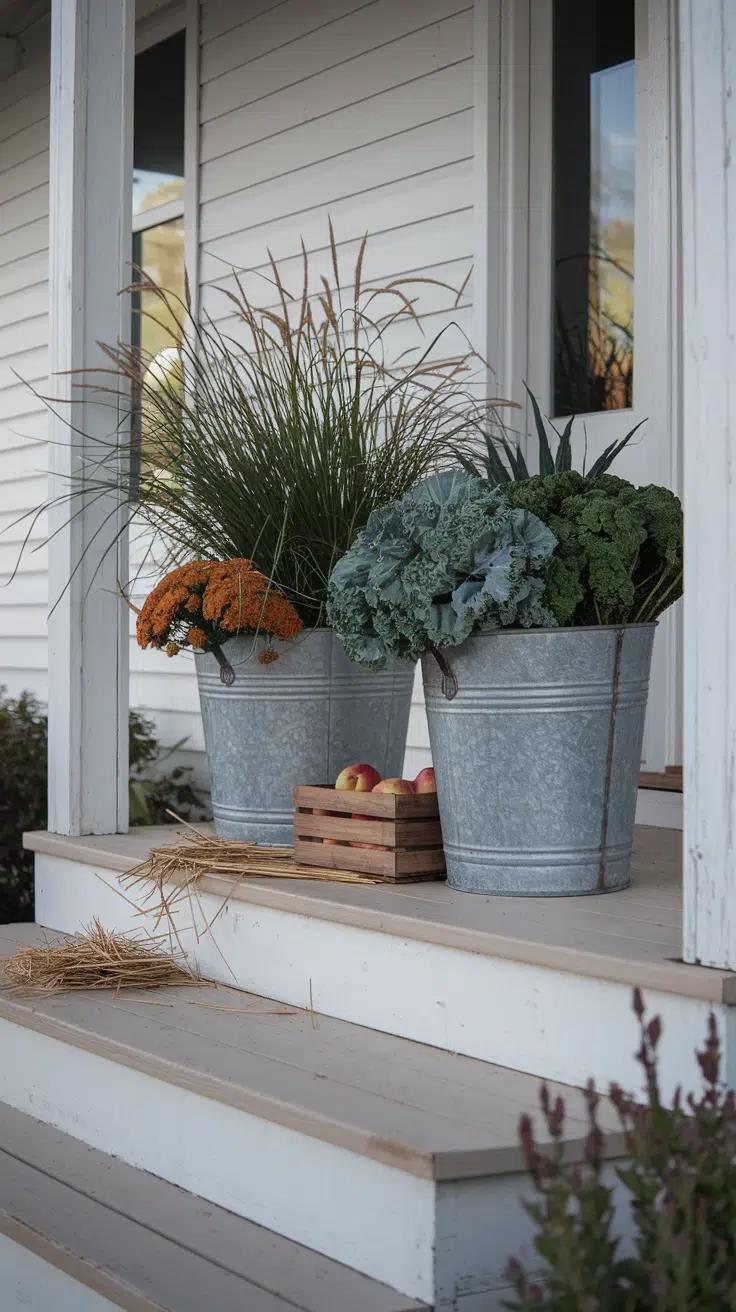
Warmth & Sanctuary
As evenings cool, home pulls you closer. Planters can echo that hug. Choose warm tones like amber, cinnamon, burgundy, and deep gold. Metals with patina—copper, bronze, galvanized finishes—add glow. Wood planters or whiskey barrels add a cozy note. And textures matter even more: fuzzy grasses, velvety leaves, rough bark, and smooth gourds.
You can weave gentle light through arrangements for night sparkle. Fairy lights or a small solar spotlight do wonders. Keep glow soft, so it feels welcoming, not blinding.

Accepting Imperfect, Lasting Beauty
Fall beauty can be rugged. It’s about structure, not delicate petals. Bare branches, seed pods, bark, and sturdy leaves carry interest longer than flimsy blooms. A pot with a chip. A terracotta finish with salt marks. Lichen on a twig. Those marks add charm.
Let plants that age well lead the show. Grasses keep shape. Kale gets richer color as nights cool. Dried hydrangea holds shape for weeks. Even a few coneflower seed heads can feed birds and keep your pot lively.
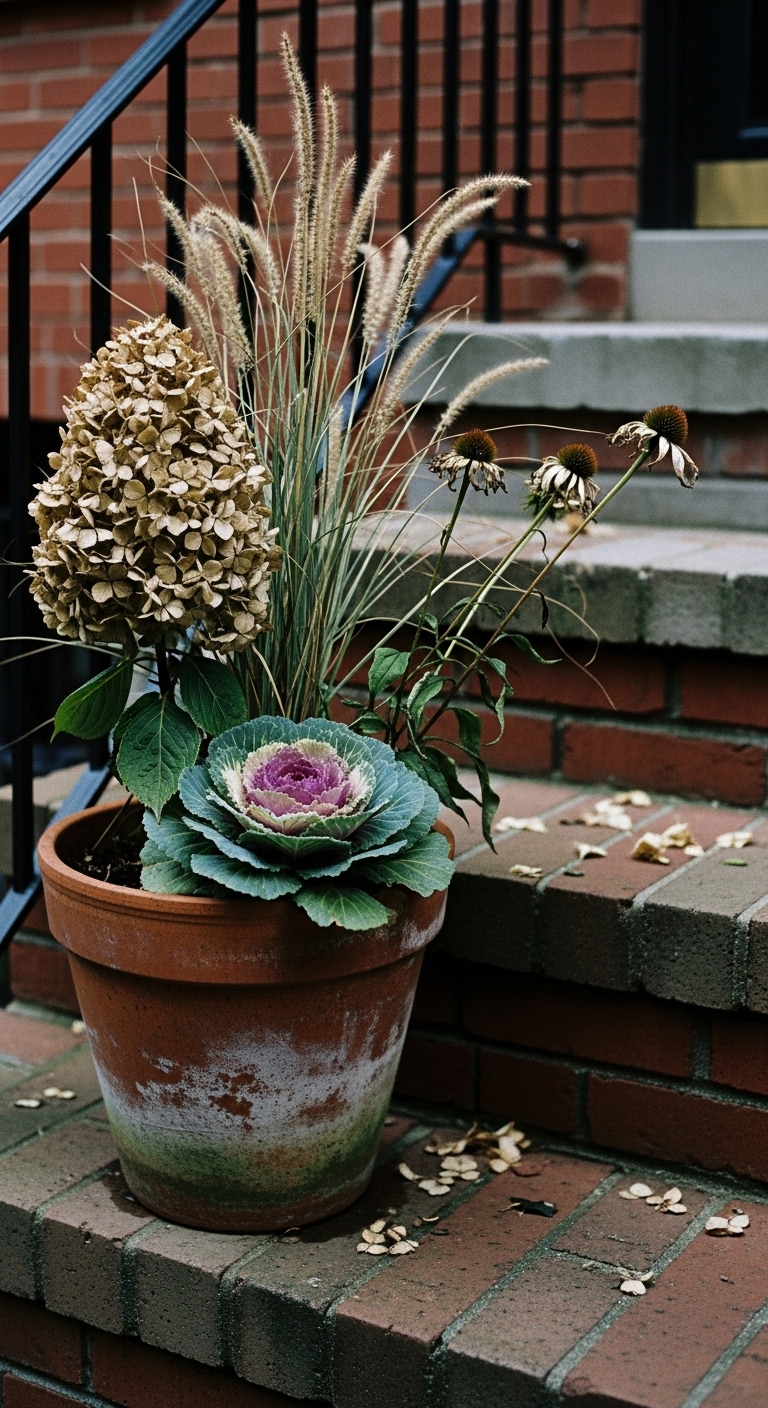
The “Thriller, Filler, Spiller” Formula — Your Foolproof Design Framework
A simple recipe makes strong containers. Place something tall for punch, something mounded for body, and something trailing for softness. That’s it. Your pot gets balance, shape, and a clear focal point. And it works for big urns, mid-size tubs, or small porch steps.
We’ll pair choices so your arrangement lasts and looks complete from day one.
Introduction to the Concept
Think of a triangle inside your pot. Tall at the back or center. Rounded shapes in the middle. Trails along the rim. That structure creates flow and depth. Match plant sizes to your container. A large urn needs heftier plants so it doesn’t look skimpy. Smaller steps look best with tidy, compact picks.
Choose a pot with drainage and fresh potting mix. Water well after planting. And keep enough space so roots can spread.
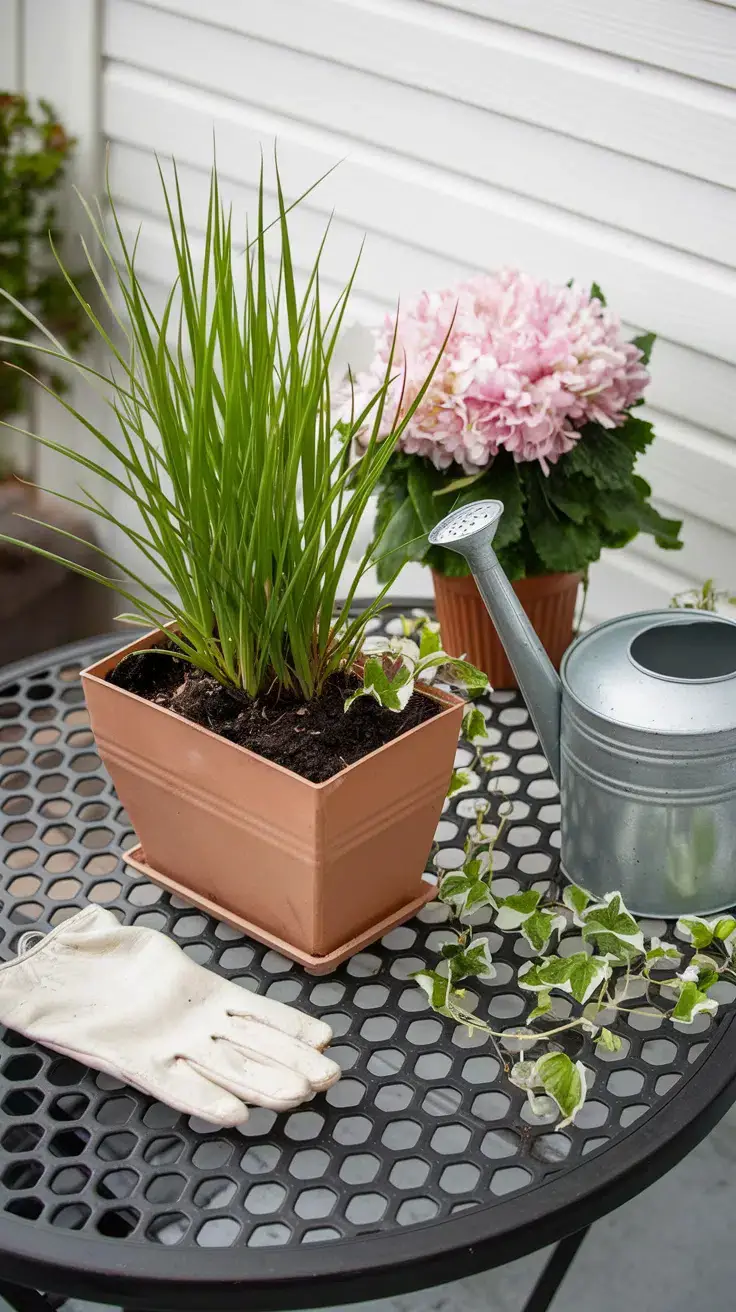
The “Thriller” — Height and Drama
Role: the tall element pulls eyes upward and sets the stage. One strong pick is better than several medium ones. Place it at the back for pots against a wall, or center it for pots seen from all sides.
Great choices include Purple Fountain Grass, ‘Karl Foerster’ Feather Reed Grass, dried corn stalks, or curly willow branches. A living evergreen like a dwarf Cypress or Juniper adds structure through winter. Stake taller stems if wind whips through your porch.
Scale matters. Aim for the planted height to feel roughly half the door’s height or slightly less. Too short looks timid. Too tall blocks sightlines.
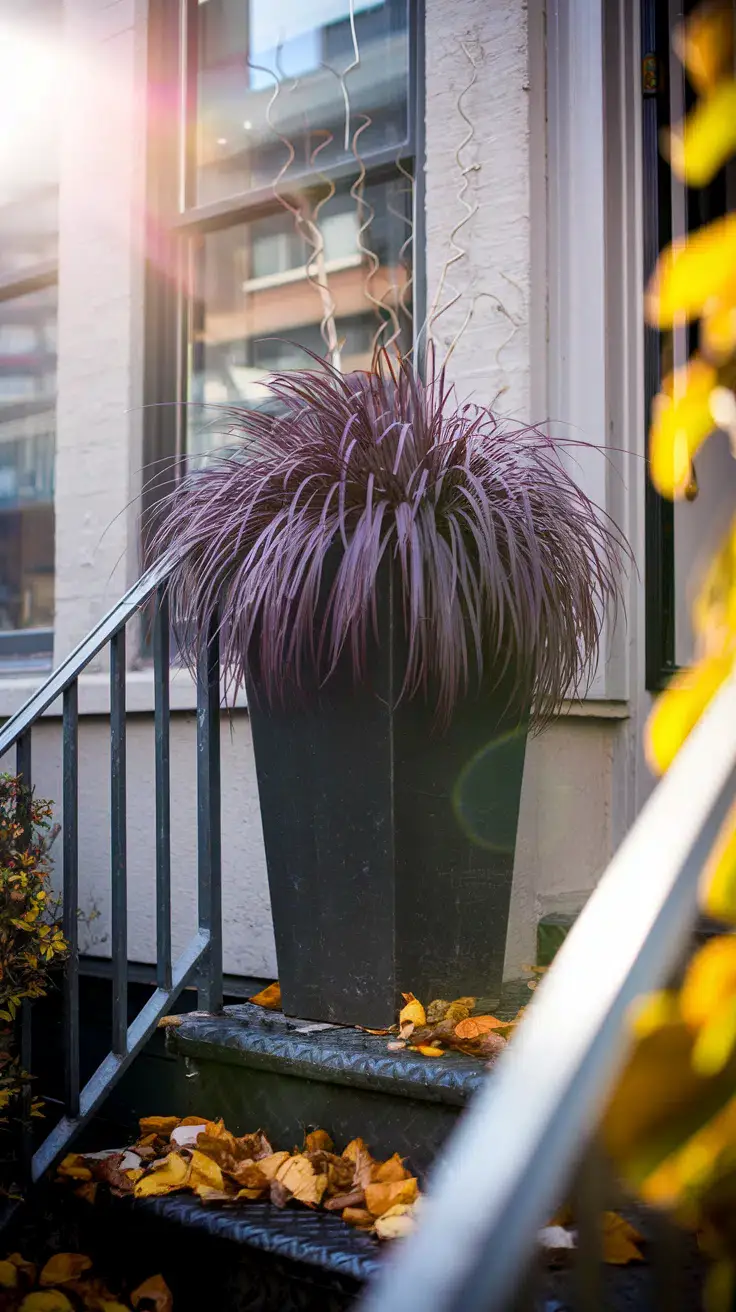
The “Filler” — Fullness and Color
Role: the middle layer brings body and the main color story. Aim for sturdy, mound-forming plants that can handle cool nights. Tuck them around your thriller, leaving a bit of space for growth.
Classic picks include mums (any tone, from jewel colors to crisp white), Ornamental Kale and cabbage, Asters, Pansies, Heuchera (Coral Bells), Celosia (Cockscomb), and Crotons for bold leaves. Mix two to three types for depth. Use repeats for unity. A trio of mums set apart by two kale creates rhythm.
Trim spent blooms on mums and asters to keep them tidy. Water near the soil line, not over the tops, so petals stay fresh. And keep soil slightly moist, not soggy.
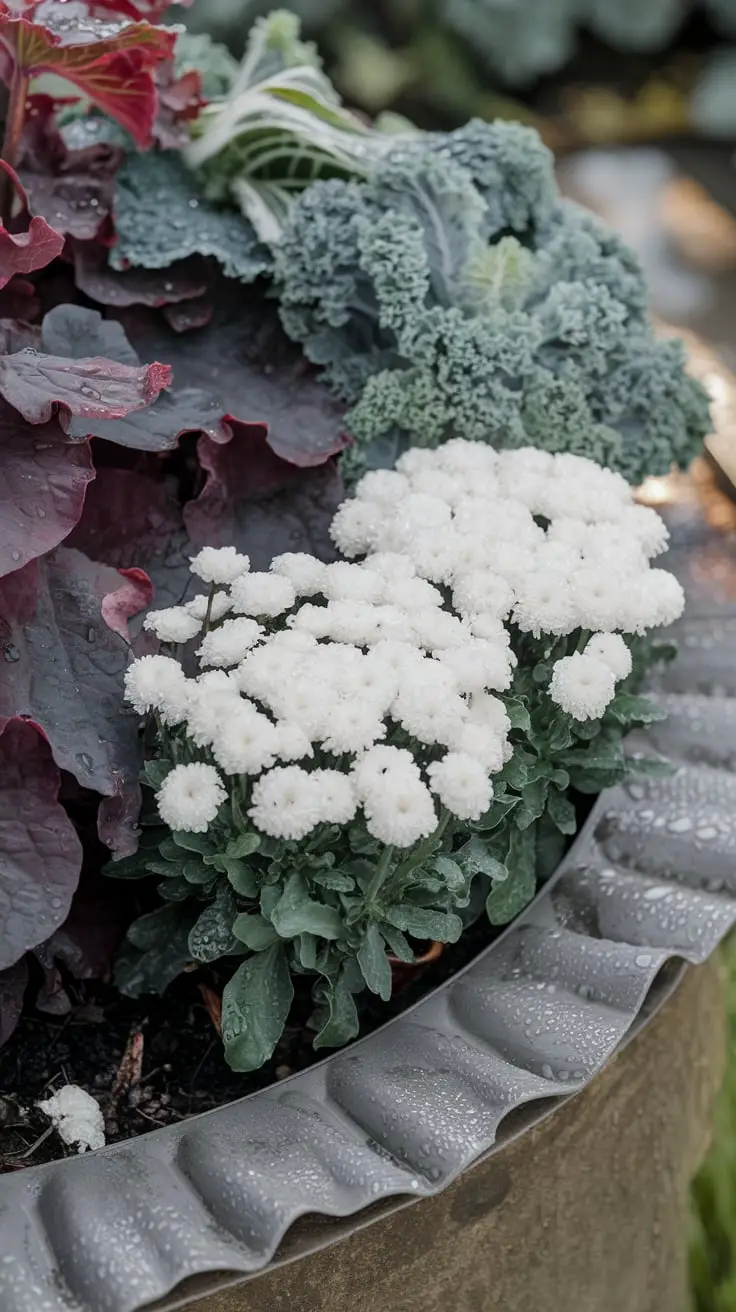
The “Spiller” — Softness and Cascade
Role: trailing plants soften edges and guide eyes downward to steps. One or two varieties usually do the trick. Let them drape but avoid blocking the path.
Strong trailers include Sweet Potato Vine (deep purple or neon chartreuse), Creeping Jenny, English Ivy, trailing vinca, and Dichondra ‘Silver Falls’. Dark purple next to pale kale looks lush. Chartreuse beside burgundy mums creates pop. Silver foliage cools a warm palette.
Pinch long stems if they start to swallow your filler layer. Keep vines off the walkway for safe footing. And rotate the pot now and then so growth stays even.
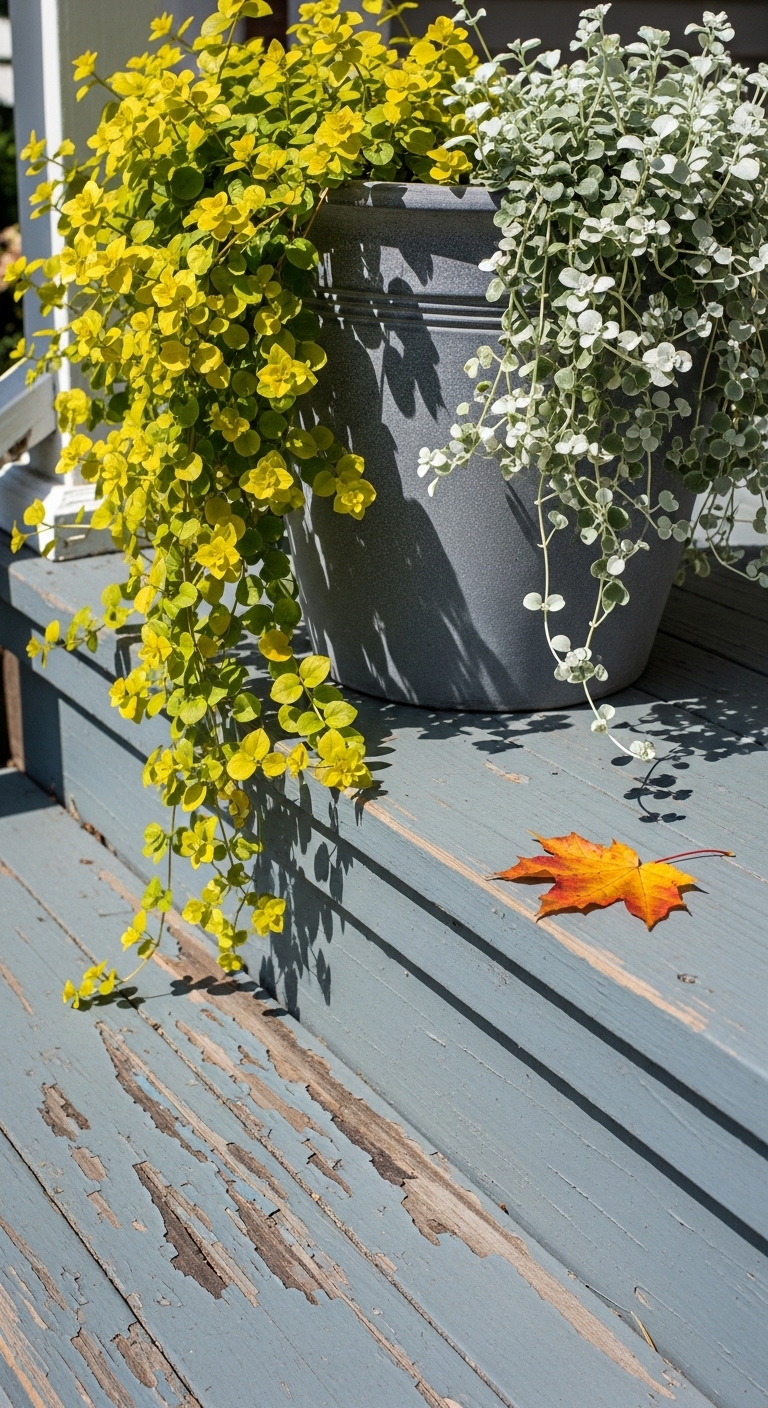
Painting with a Fall Palette — Mastering Color & Texture Combinations
Color tells the story before anyone rings the bell. Start with a fall color palette that matches your home and the light on your street. Then let texture carry the mood. And use contrast so every layer stands out.
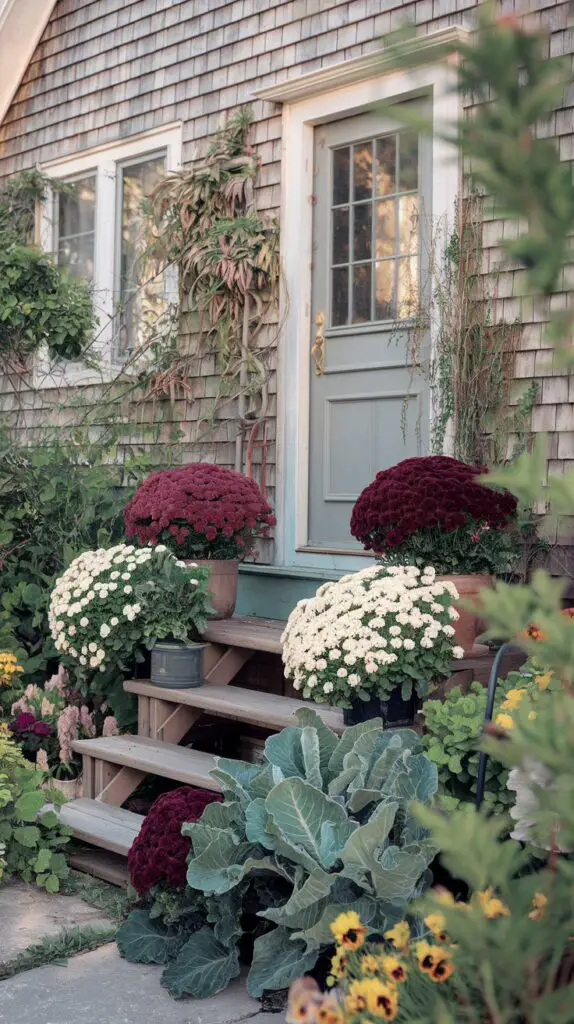
Beyond Orange
Pumpkins are great, sure. But your pots can wear many colors. Work within a tight scheme so the arrangement feels calm and intentional. Limit to three main hues and one accent. Keep leaf shapes varied so it never looks flat.
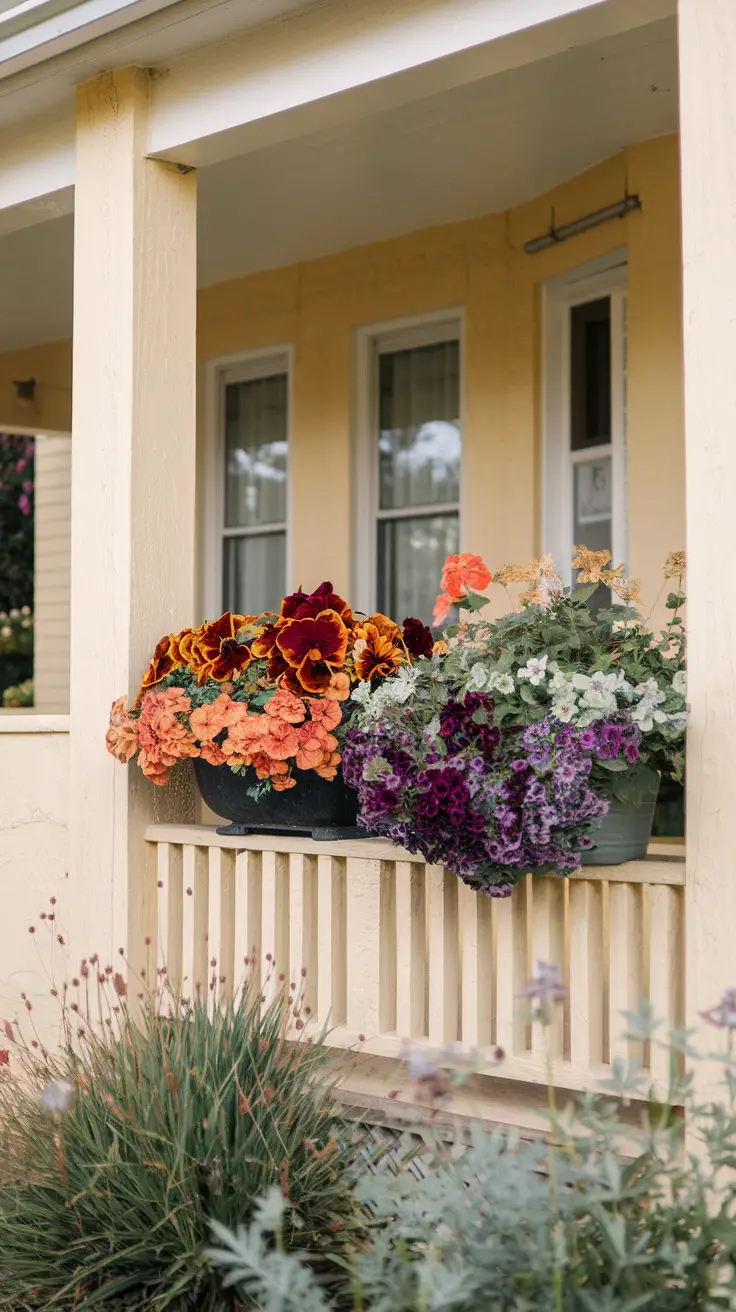
The Classic Harvest
Go warm and rich. Think deep reds, corroded copper tones, and golden yellows. Choose:
- Bronze or rust mums
- Asters in red-purple
- Ornamental peppers in sunset shades
- Blue-green ornamental cabbage for cool balance
- Fountain grass for height
Tie it together with a mat or lantern in a warm metal tone.
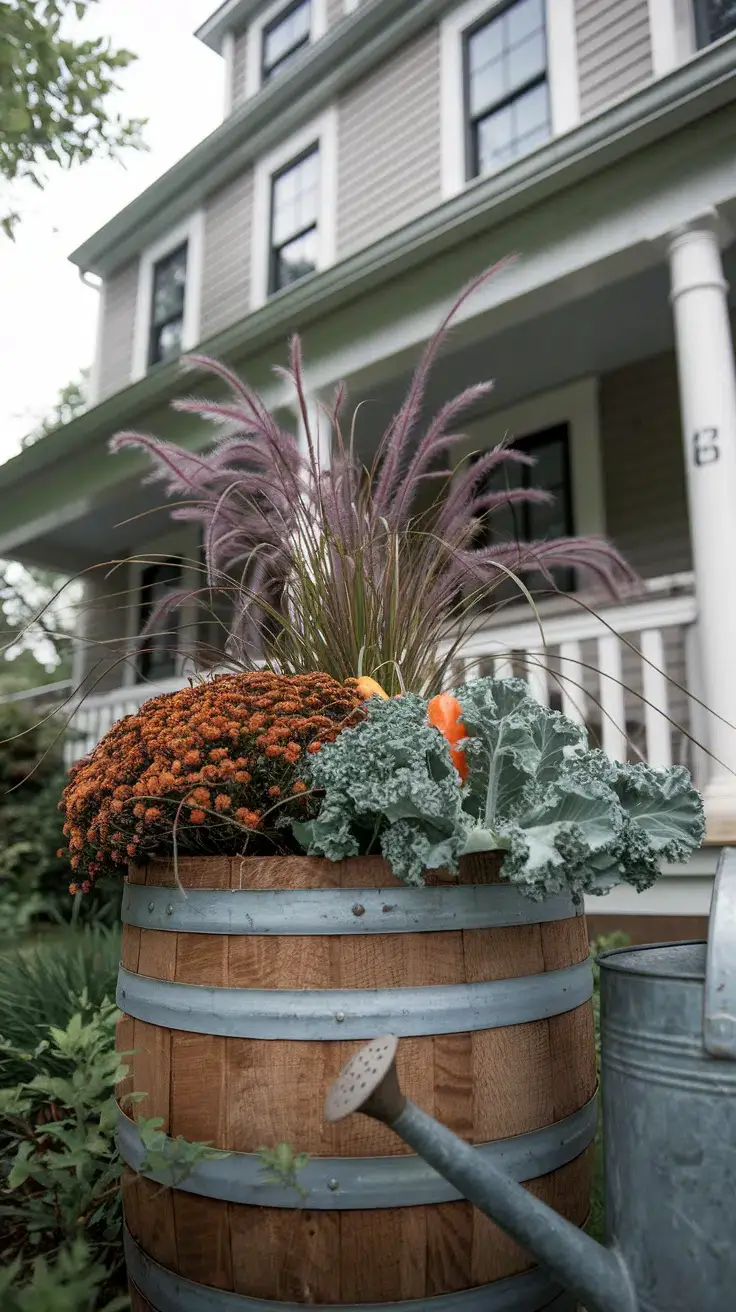
The Moody Jewel-Tone
Aim for drama without shouting. Use plums, burgundy, deep purples, and dark greens. Accent with silver or gold for spark.
- Heuchera in blackberry or merlot shades
- Dark purple asters
- Burgundy mums or celosia
- Dichondra ‘Silver Falls’ for cool sheen
- Small gold gourds as accents
Restrain bright orange so tones stay luxe.

The Rustic Farmhouse
Keep it calm and soft. Use creams, whites, sage, and dusty blues. Lean on leaves and form.
- White mums or pansies
- Ornamental kale in blue tones
- Lamb’s ear for softness
- Feather reed grass for structure
- Pinecones or birch branches for texture
Natural wood planters fit right in.
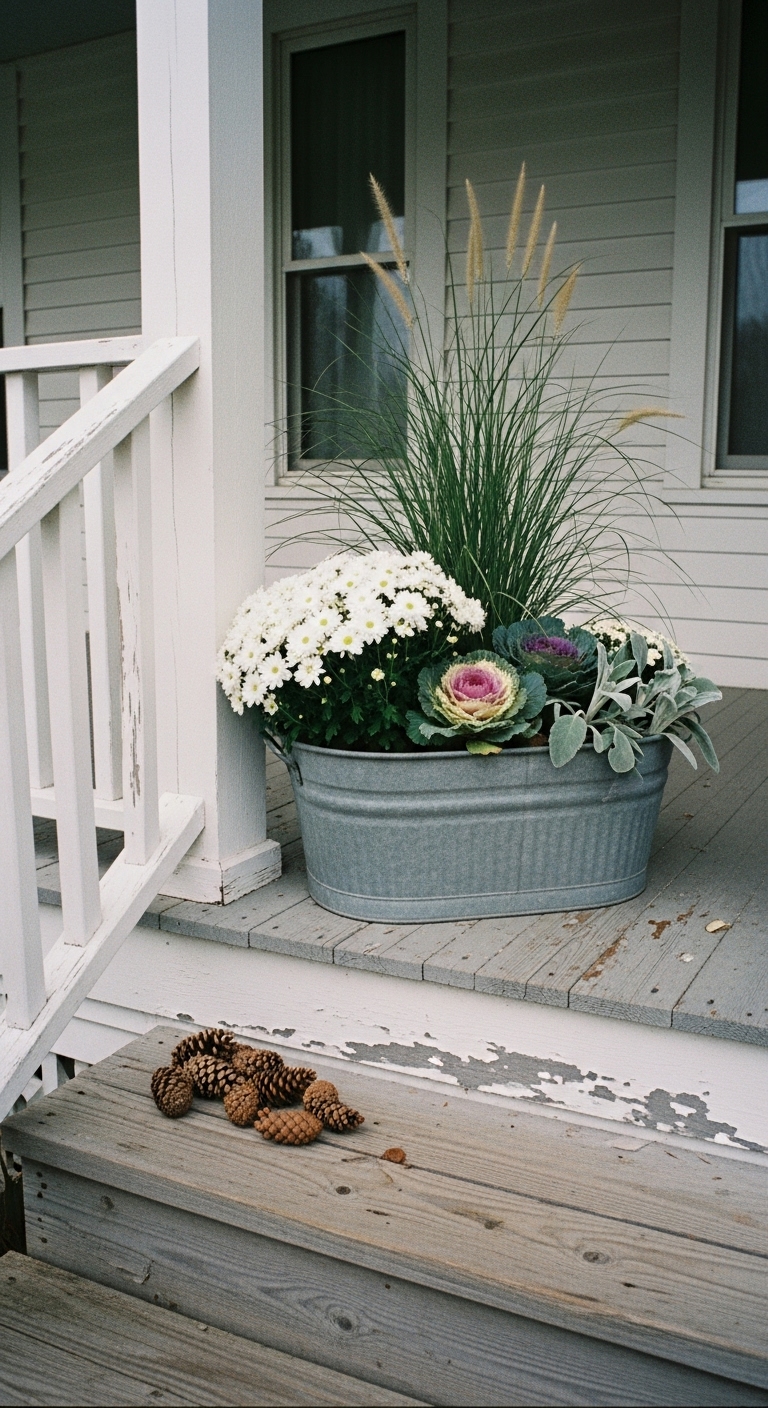
Texture Is the New Bloom
Temperatures dip. Petals fade faster. Texture holds steady. Spiky next to velvety. Glossy beside matte. Smooth against rough. That mix gives depth even on gray days.
- Pair grass blades with cushiony mums
- Ruffled kale beside trailing ivy
- Smooth gourds with flaky bark
- Soft lamb’s ear near shiny croton leaves
- Seed heads with pansy faces
Small contrasts read loud up close at a doorstep.

Creating Contrast
Use one dominant texture, then layer the opposite. Strong spikes? Add ruffles. Lots of glossy leaves? Add fuzzy or silver foliage. Repeat each texture at least twice in the arrangement so it looks intentional. And keep densities varied so the eye has resting spots.
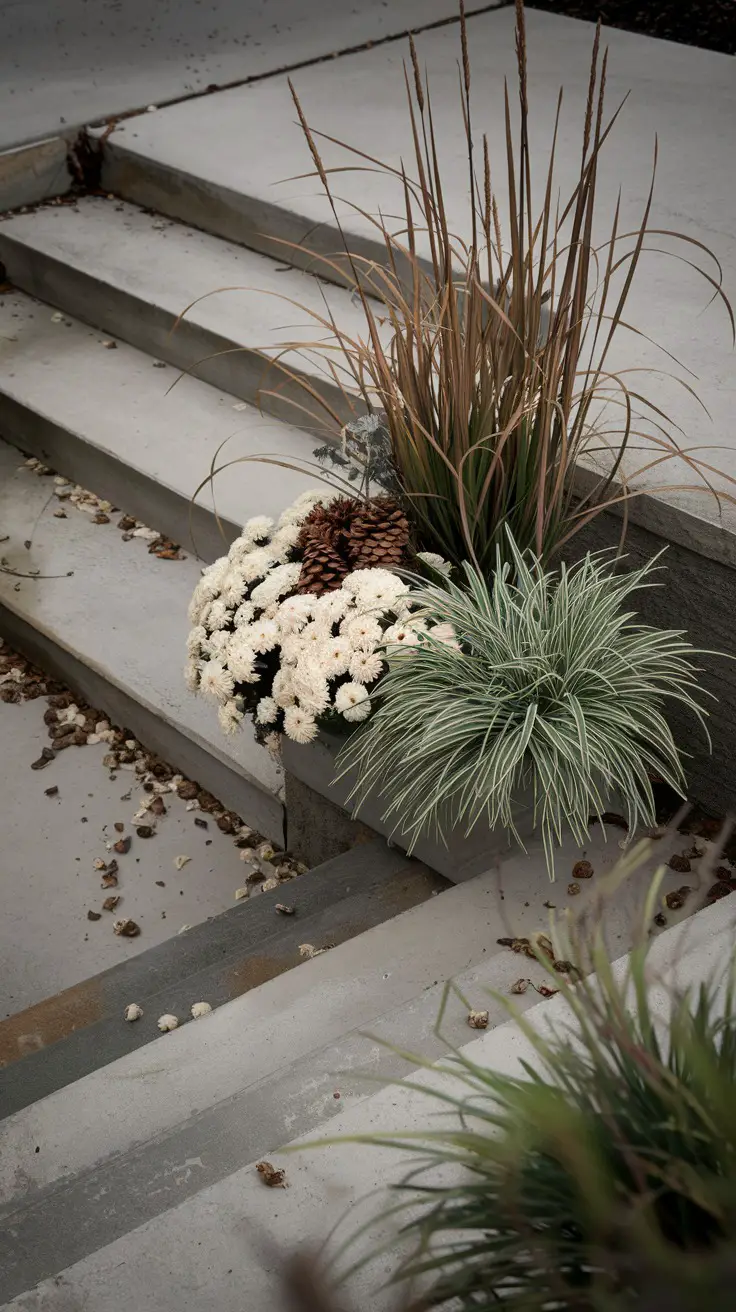
Plant Selection for Every Porch — Full Sun vs. Shade Solutions
Placement is half the game. Sun, wind, and overhangs shape plant success. Start by knowing your full sun or shade level. Then pick plants that like those conditions. Pots near walls can run dry faster. Wind on steps can stress tall stems. A little planning saves money and time.
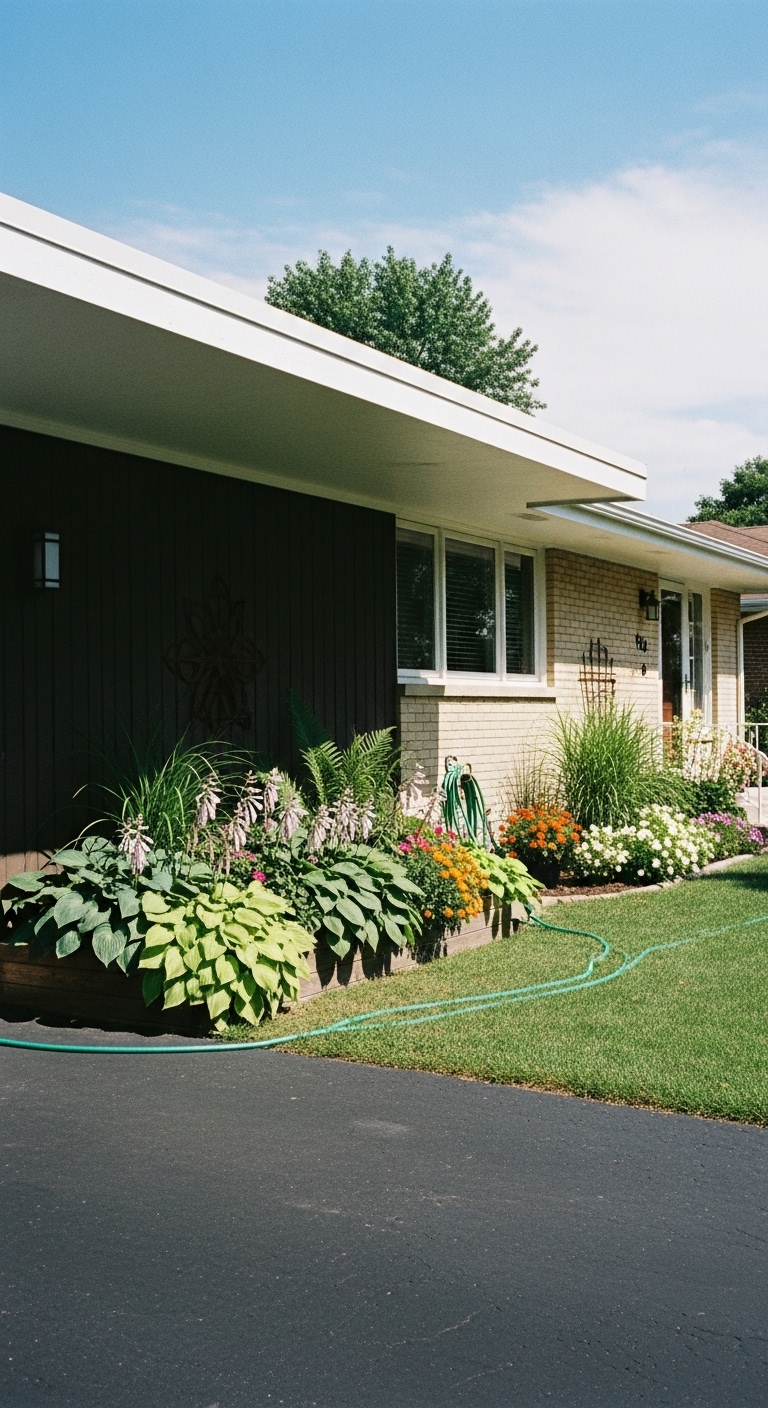
The Key to Success Is Location
Count hours of direct light on your porch. Overhangs can cut light even on a south-facing house. Reflective surfaces boost heat near brick and pavement. Wind tunnels near alleys can topple tall thrillers, so stake if needed. Group pots to create a microclimate and share humidity. And use larger containers for more stable moisture.
For Sun-Drenched Porch Spots (Full Sun)
Think 6 or more hours of direct light. Choose plants that can handle heat and bright conditions:
- Mums in jewel or white tones
- Asters for late color
- Ornamental peppers for fruit and shine
- Sedum ‘Autumn Joy’ for sturdy blooms
- Purple Fountain Grass or ‘Karl Foerster’
- Pansies for cool nights
- Ornamental kale for strong color as temps drop
Tips:
- Water deeply, then allow the top inch to dry slightly.
- Morning sun with afternoon shade reduces stress where heat is intense.
- Deadhead mums and asters to keep a fresh look.
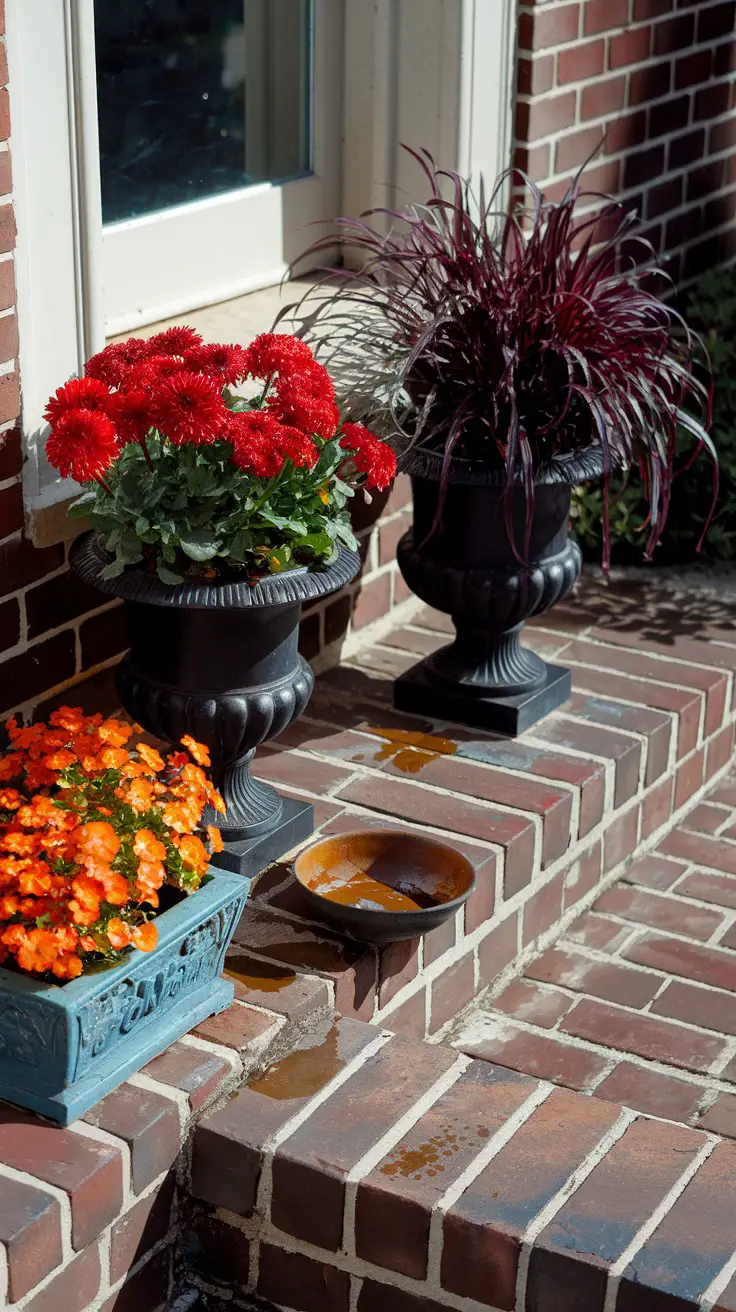
For Covered & Shady Porch Spots (Shade)
Less than 4 hours of direct light, often filtered or morning-only. Choose foliage stars:
- Heuchera (Coral Bells) for color-rich leaves
- Autumn fern for airy fronds
- Coleus for bold patterns
- Lamium (Dead Nettle) for silver leaves
- English ivy for trailing
- Torenia (Wishbone Flower) for pops of bloom
- Hosta in big containers where space allows
Tips:
- Use lighter-toned foliage to brighten dim corners.
- Keep soil slightly moist; shade spots still dry faster in wind.
- Rotate pots so growth stays even.
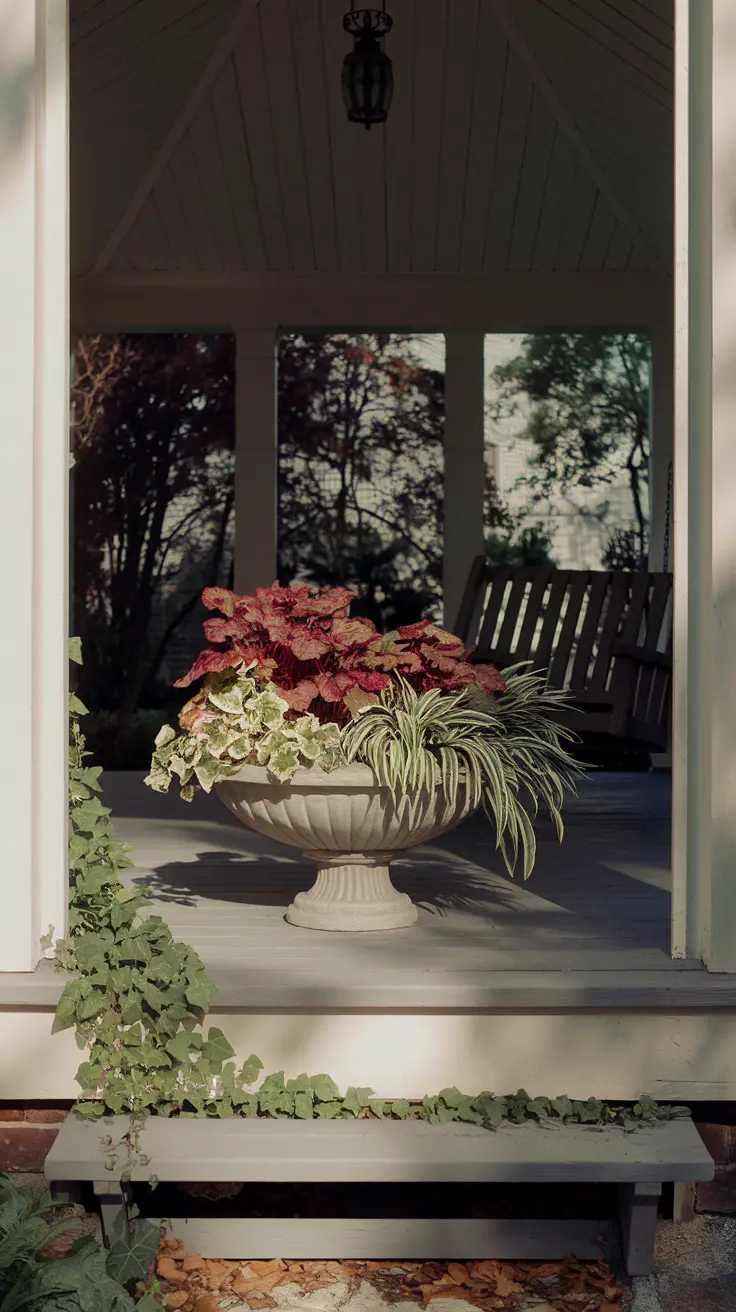
A Note on Watering
Cool air tricks people into watering less. Containers can still dry quickly, especially in sun and wind. Check moisture with a finger test two inches down. Water in the morning so leaves dry sooner. Add mulch on top of the soil to slow evaporation. And use a saucer only if you can dump standing water after storms.
Front Porch Fall Planters with Fake Plants & Natural Decor
Busy schedule? Tough light? You can still have strong fall style. High-quality faux stems can save the day. Mentioning front porch fall planters fake plants helps readers who search for zero-maintenance ideas. Go for pieces that look real from a few feet away, not shiny plastic. And blend them with real items so the whole scene feels grounded.
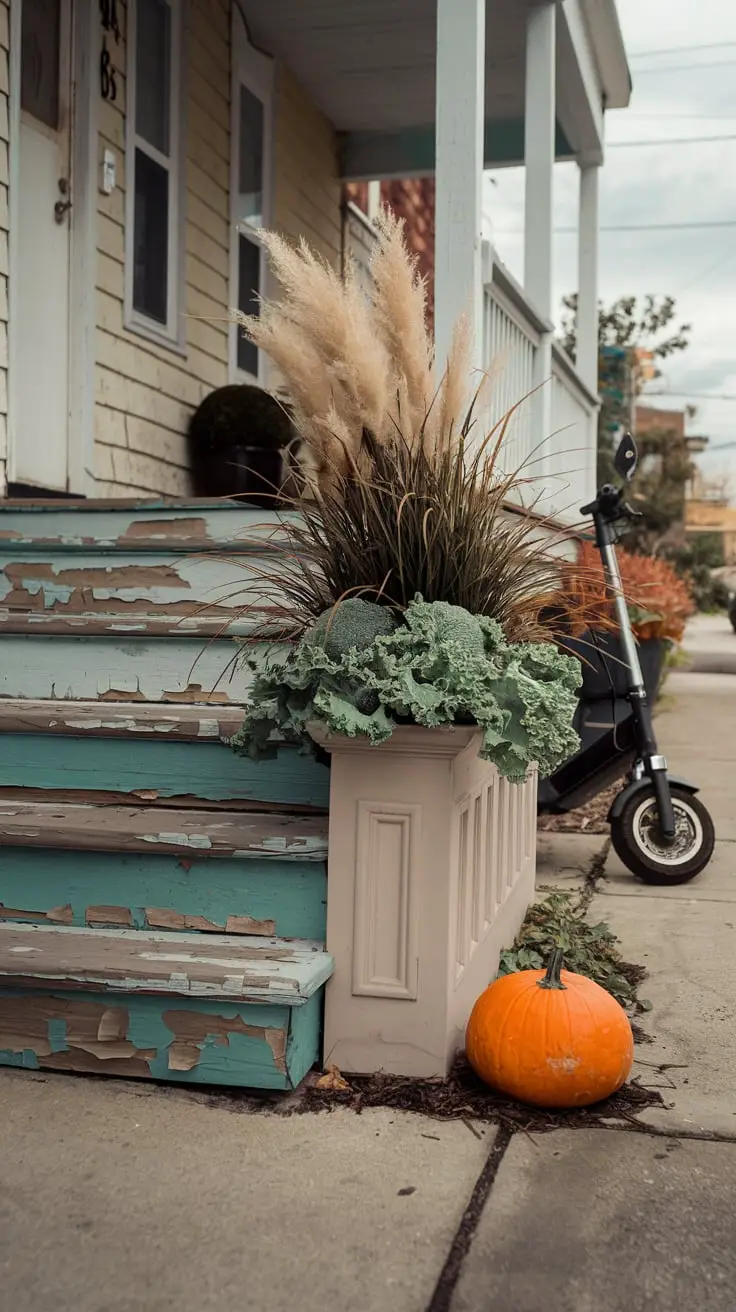
The Zero-Maintenance Option: Leveraging Faux Greenery
Quality faux stems can handle deep shade, heavy wind, or travel days without a wilt. They last multiple seasons. You can bend stems to shape and anchor them in dry floral foam tucked inside the pot. Cover the base with bark, moss, or a thin top layer of real potting mix so nothing looks staged. And you can still add a live element or two for scent and life.
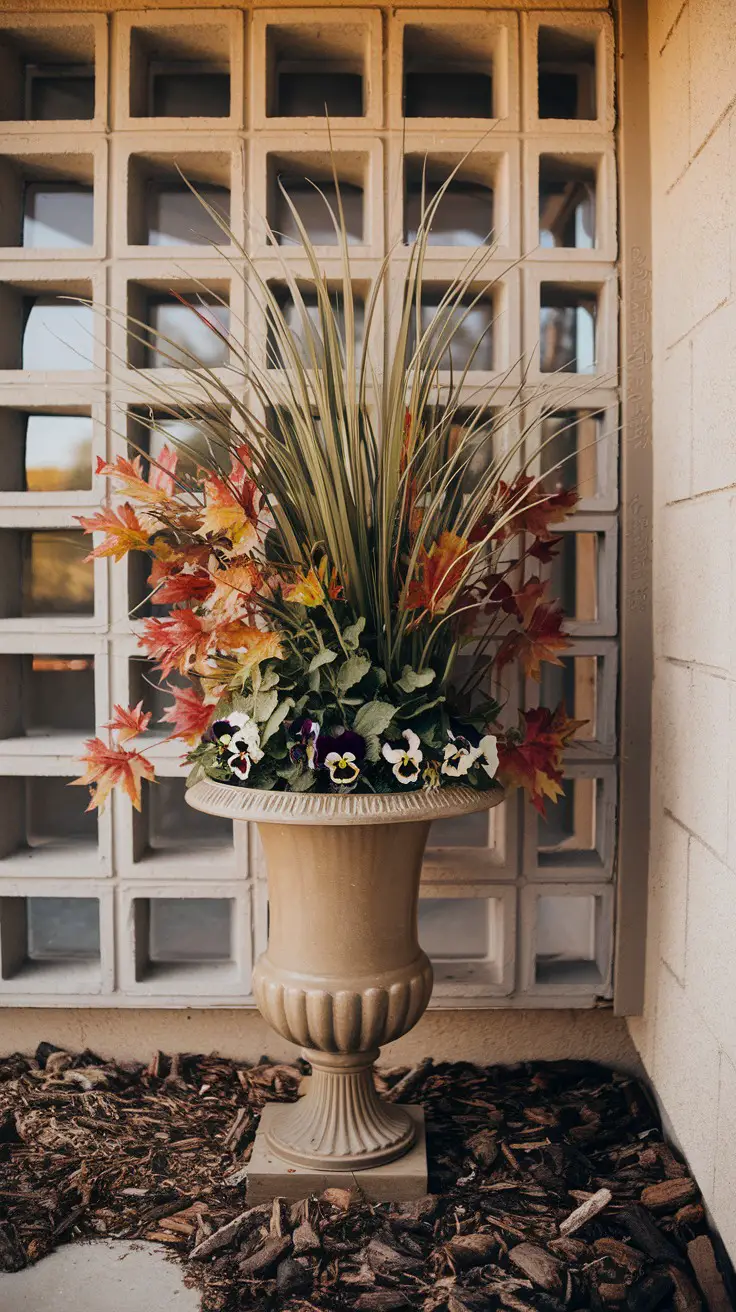
Best Bets for Faux
Some plants look convincing even in budget lines. Others don’t. Pick pieces with matte finishes and subtle color shifts.
- Faux ferns for shade corners
- Artificial grasses with varied blade widths
- Autumn leaf stems in russet and burgundy
- Faux berries in deep red or amber (use sparingly)
- Branches like curly willow or birch twigs
Avoid plastic shine on ivy or glossy pumpkins that scream fake. Blend with real items for a mixed-media feel.
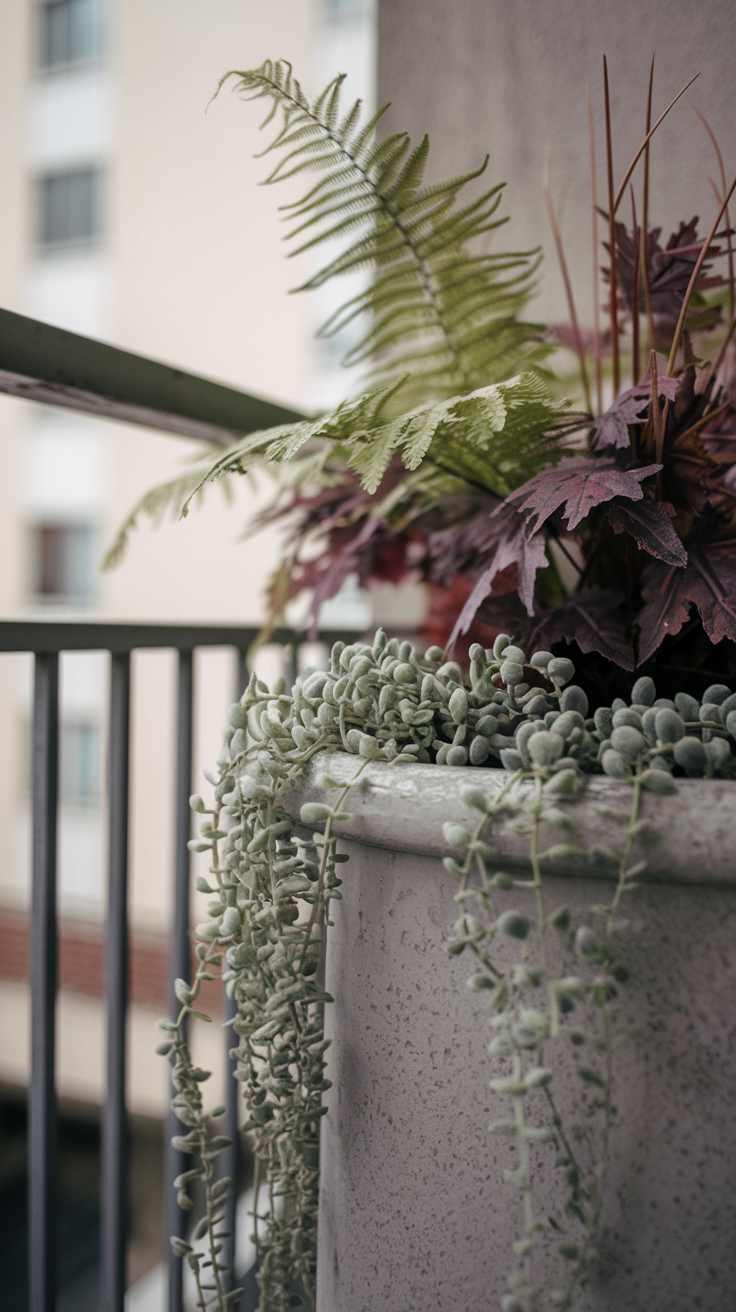
The “DIY” Decor Touch: Found & Foraged Elements
Add soul with things you can gather or pick up cheap. Use sticks, cones, pods, and seasonal produce. Mentioning front porch fall planter decor helps readers find ideas. And bold DIY energy keeps costs low and creativity high.
- Mini pumpkins and gourds set on the soil
- Pinecones tucked into gaps
- Birch logs or driftwood for vertical interest
- Dried corn cobs or husks
- Lotus pods or seed heads from your beds
- Cinnamon bundles tied with twine
Anchor heavier items with floral picks or bamboo skewers pushed into the soil. Keep pathways clear for safe steps.

Styling Tip: Make It Last
Think layers that can flex with the month. Add pumpkins for an October weekend. Pull them out later to simplify watering. Keep dried elements for structure past first frost. Rotate faux stems in and out as live flowers ebb. And refresh the top inch of soil mid-season to keep things tidy.
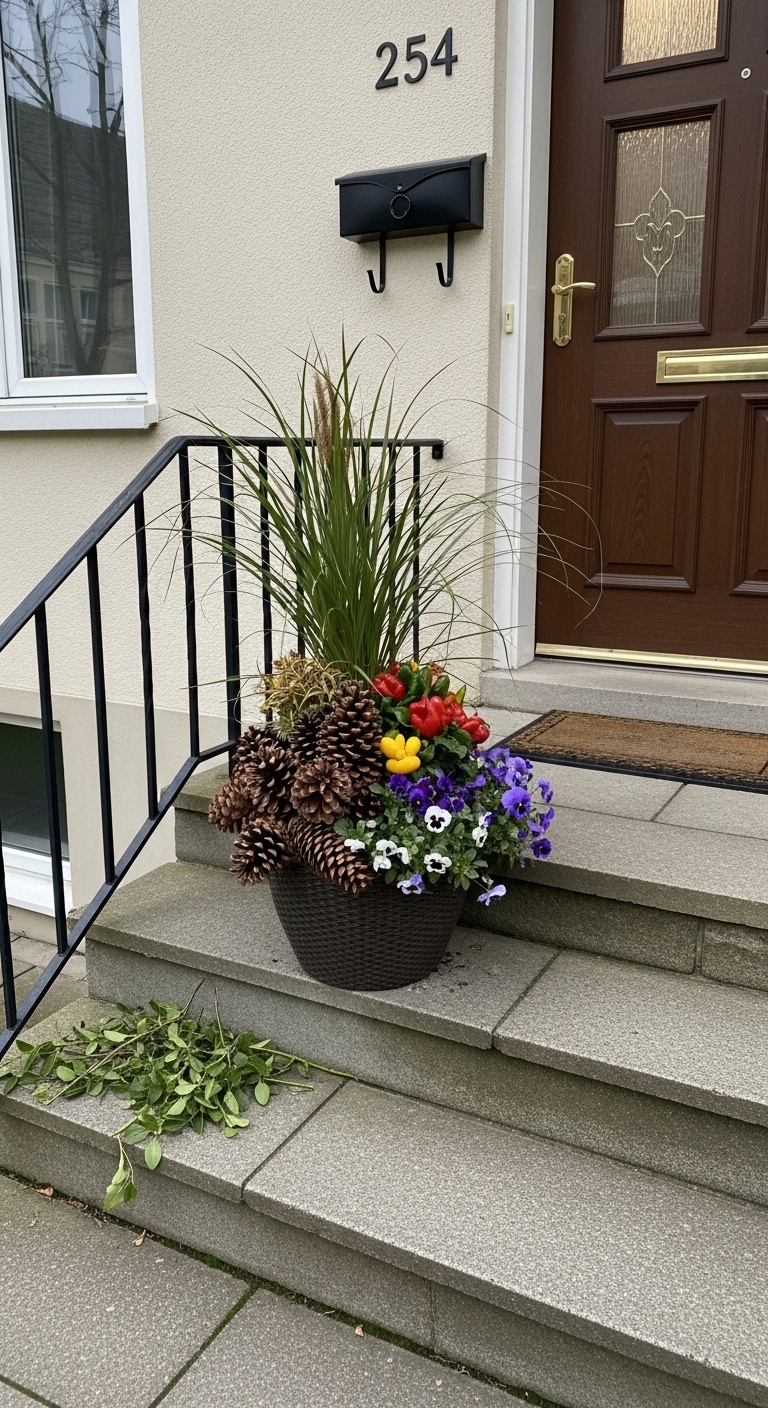
Front Porch Fall Planter Styling Tips for a Polished Entrance
Final touches pull everything together. Little choices matter at the door. A cohesive scene feels calm, layered, and welcoming.
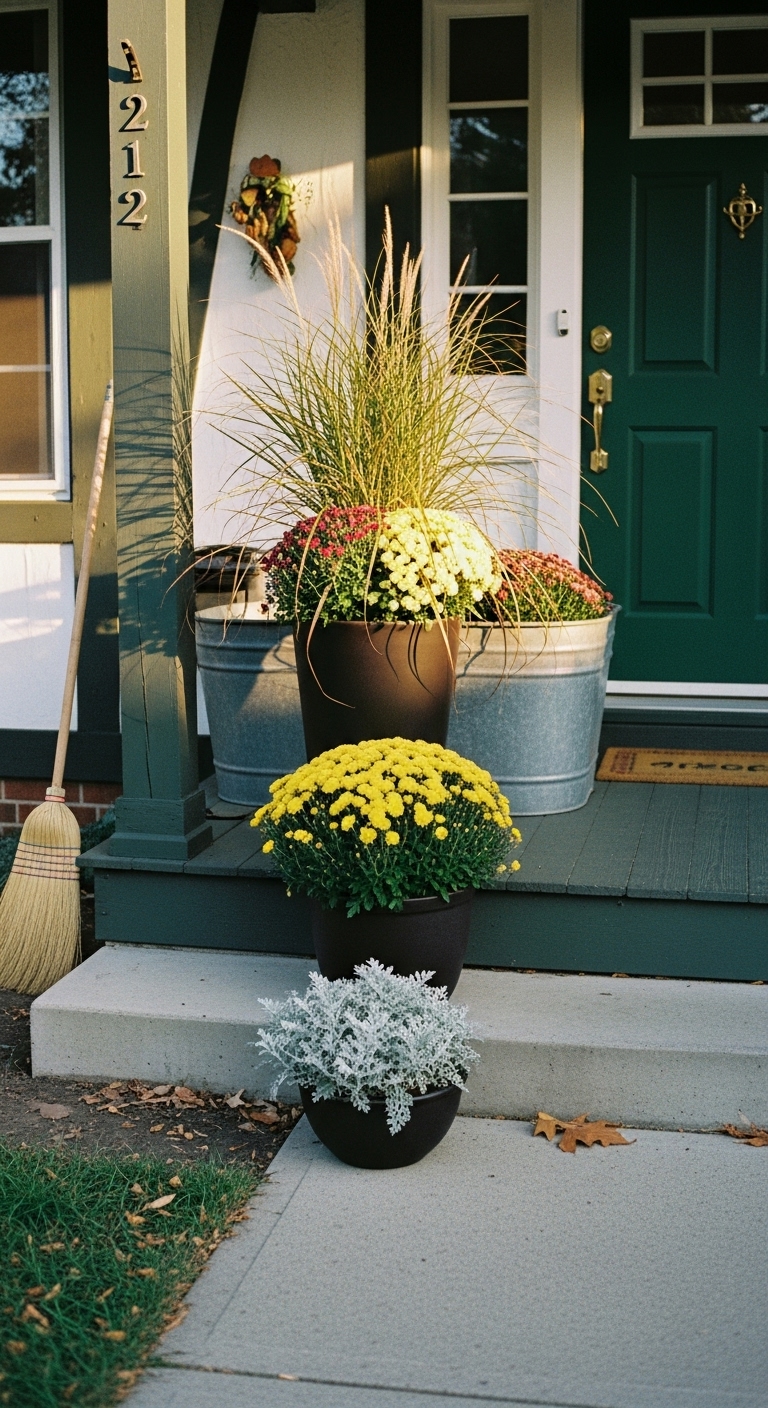
Creating a Cohesive Scene
Repeat key colors and textures. Echo leaf shapes. Carry one material across pieces. A copper lantern near a copper-toned planter band makes a quiet link. Match metal finishes on house numbers and door hardware. Add one fabric touch, like a woven mat, to warm the setup. Leave a bit of open space so the eye can rest.
- Pick one main hue, one support, and one accent.
- Repeat each at least twice on the porch.
- Keep walking paths clear and safe.
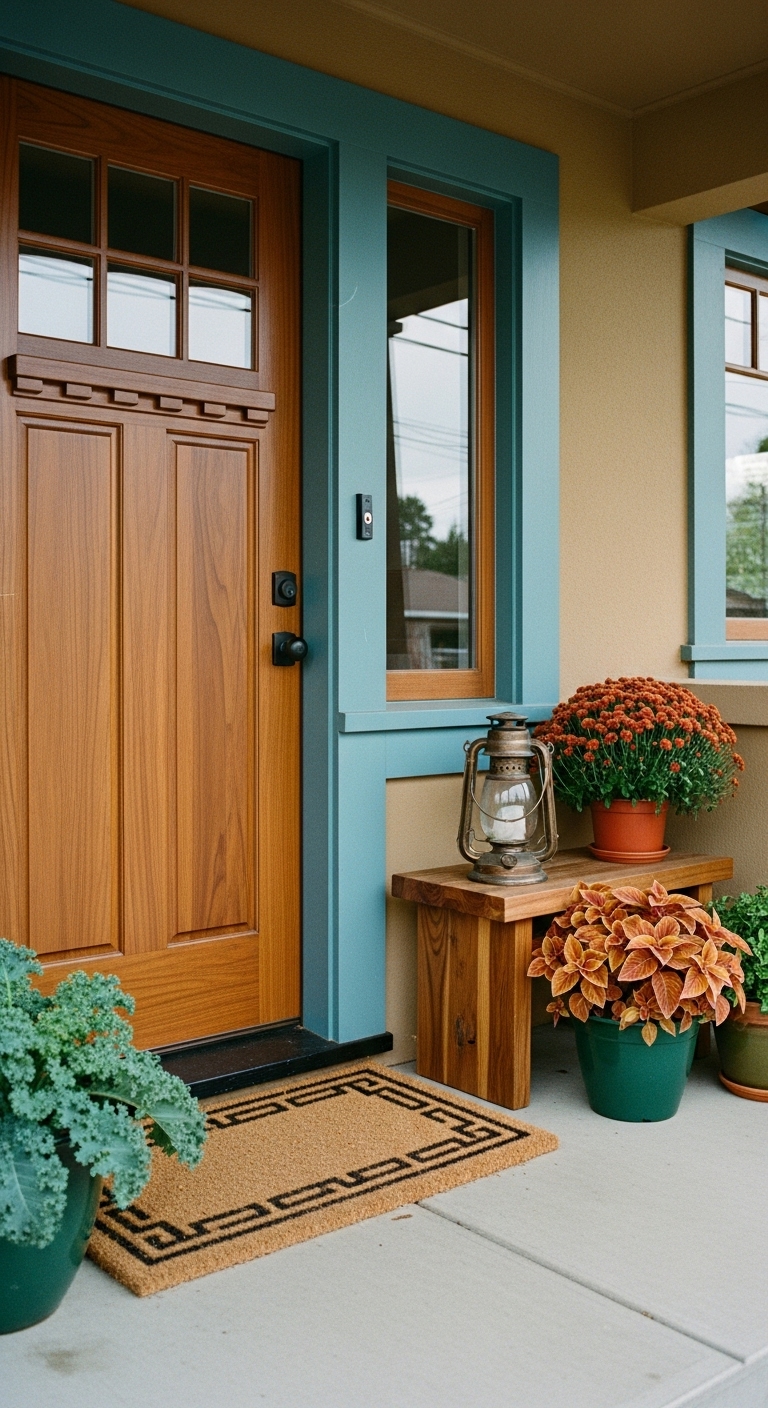
Symmetry and Asymmetry
Both styles work. Symmetry feels formal and grand. Two identical planters flanking the door say stately. Asymmetry leans modern and relaxed. One larger arrangement balanced with a smaller companion and a lantern feels easy. Let your architecture guide you. Columns and centered doors favor pairs. Offset entries and narrow stoops often suit a cluster.
- Even numbers read classic.
- Odd numbers feel casual and fresh.
- Keep the visual weight balanced, not equal.
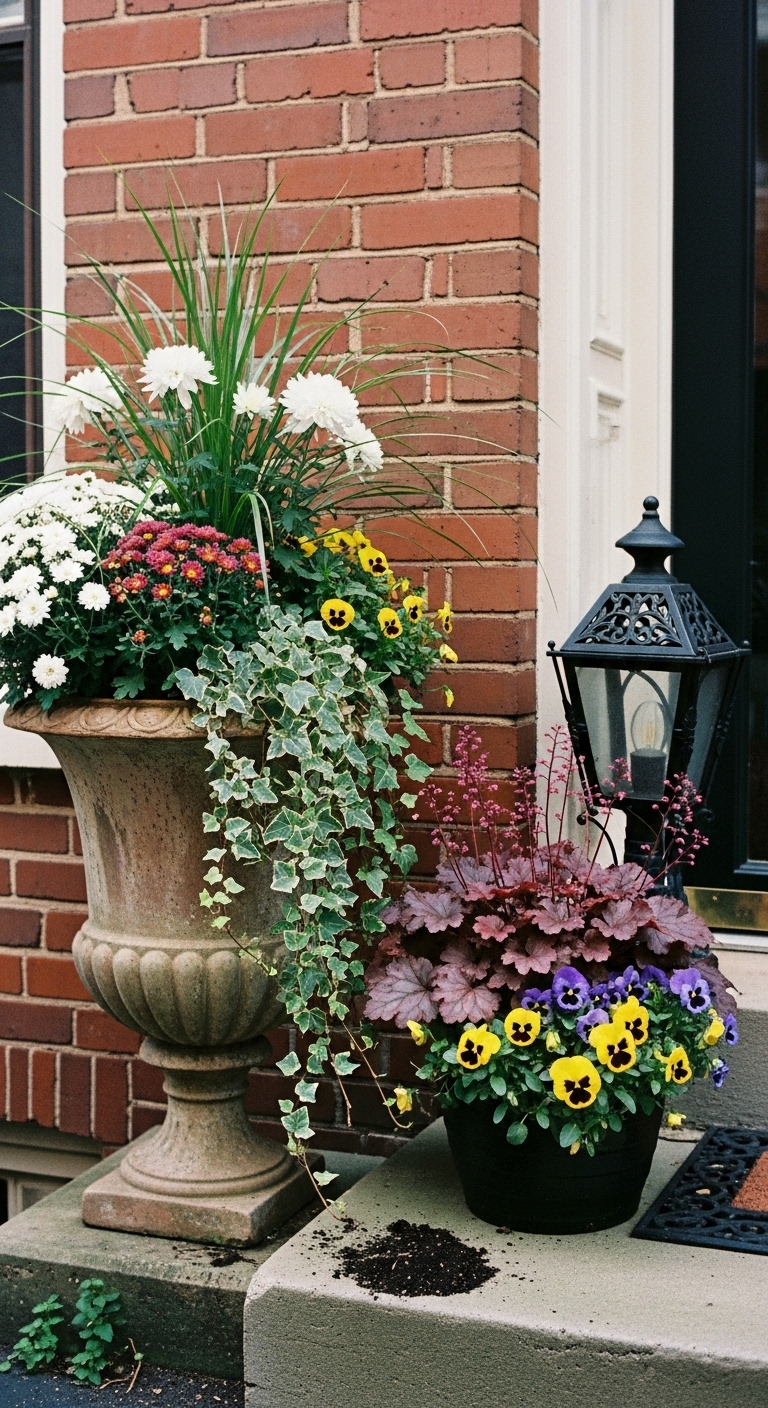
Play with Scale
Think in heights. Scale creates depth. One tall, one medium, one low is a simple formula that works. The tallest element should sit near the door or at the back of a grouping. Step down toward the path. Bigger pots hold moisture longer and look right against taller walls. Petite containers shine on steps or rail ledges.
- Aim for your tallest planted element to be about half your door height or a bit less.
- Keep paths at least 30 inches clear.
- Use plant stands or overturned crates to lift shorter pots.
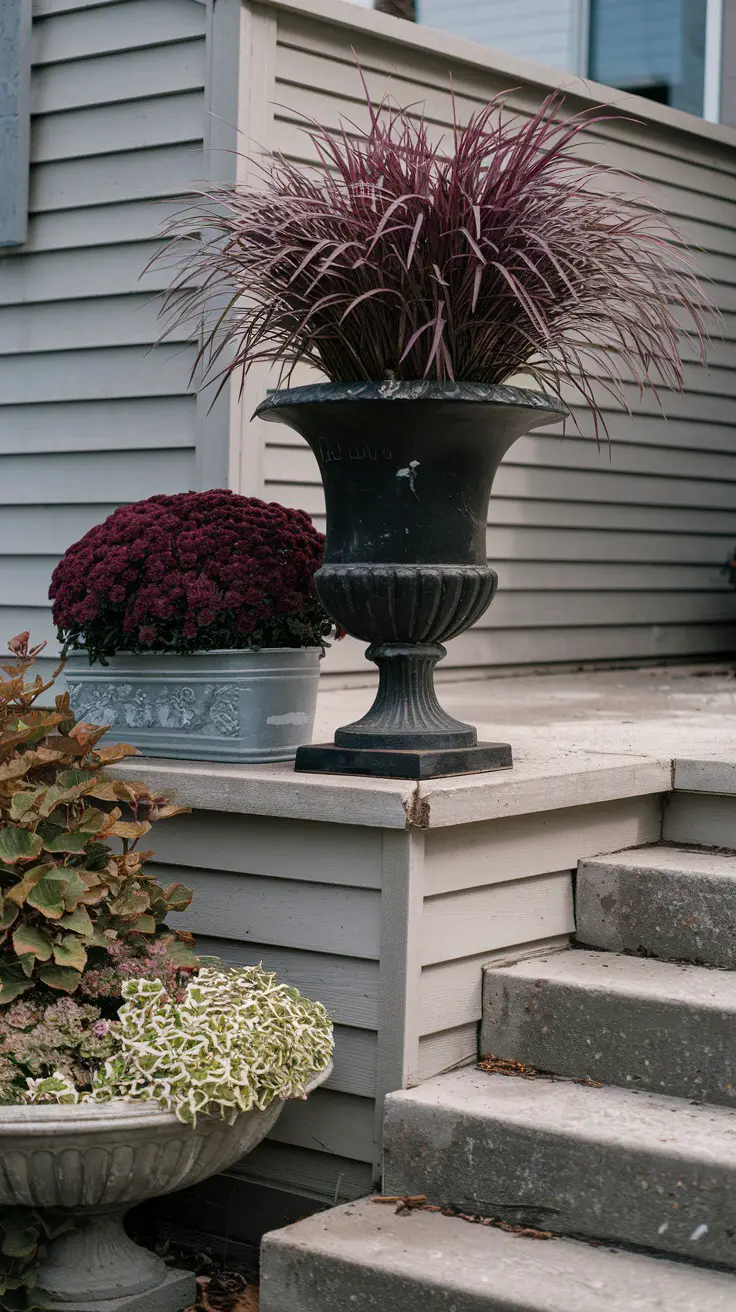
Lighting Your Creation
Soft glow adds magic. A compact solar spotlight can graze light across grass plumes or the front of your planter. Warm fairy lights woven through stems create sparkle without glare. Choose warm white tones, not icy blue. Use timers for consistency. Hide cords and stakes under foliage. Aim beams away from neighbor windows and the street.
- 20–40 lumens is plenty for accents.
- Test at dusk, then adjust.
- Keep lights off dry leaves during windy nights.
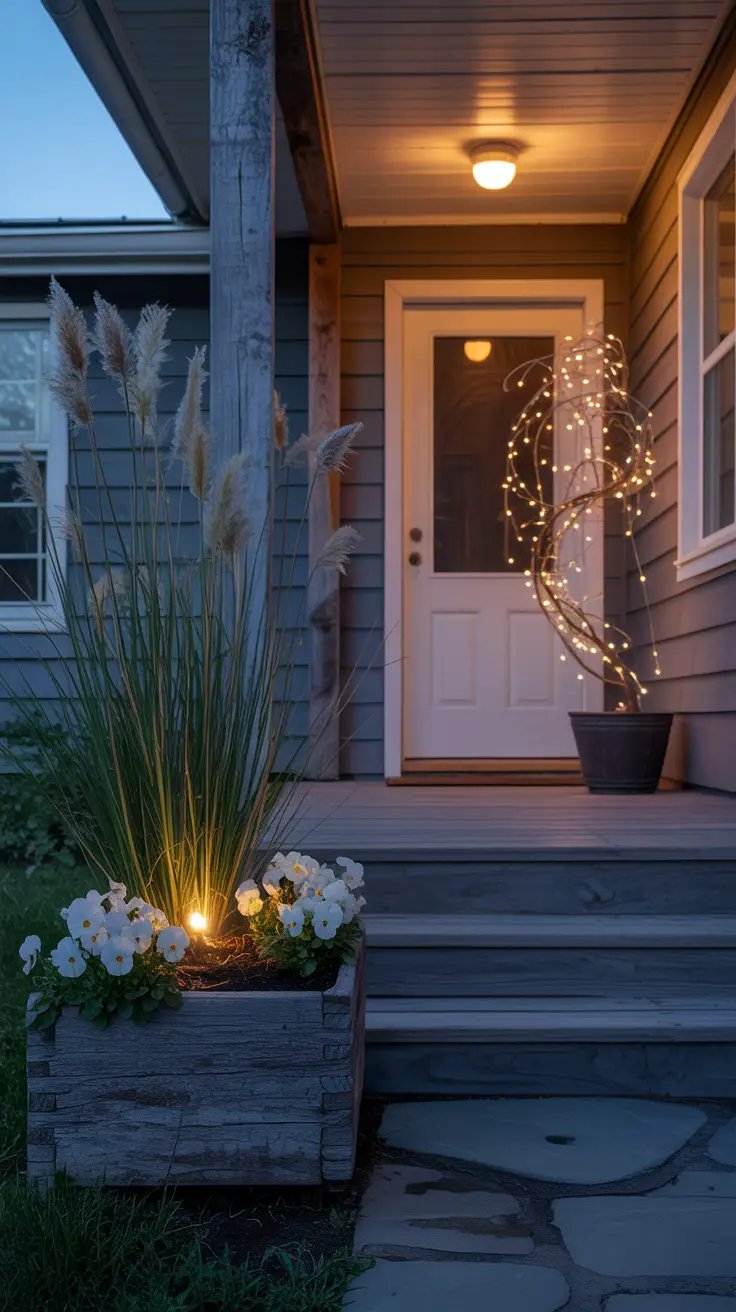
Harmonize with Your Home
Match your planter colors to the story your house already tells. A black door loves silver foliage and white blooms. A red door pops with sage and plum. Stained wood pairs well with rust and cream. Echo shutter shades in pansies or kale. Pull metal finishes from your mailbox or light fixture. Tie in a wreath that repeats one plant color or texture for a simple fall decor scheme.
- Choose pot finishes that link to trim or railings.
- Keep one repeating plant across both sides of the door.
- Let your door color guide one accent choice.
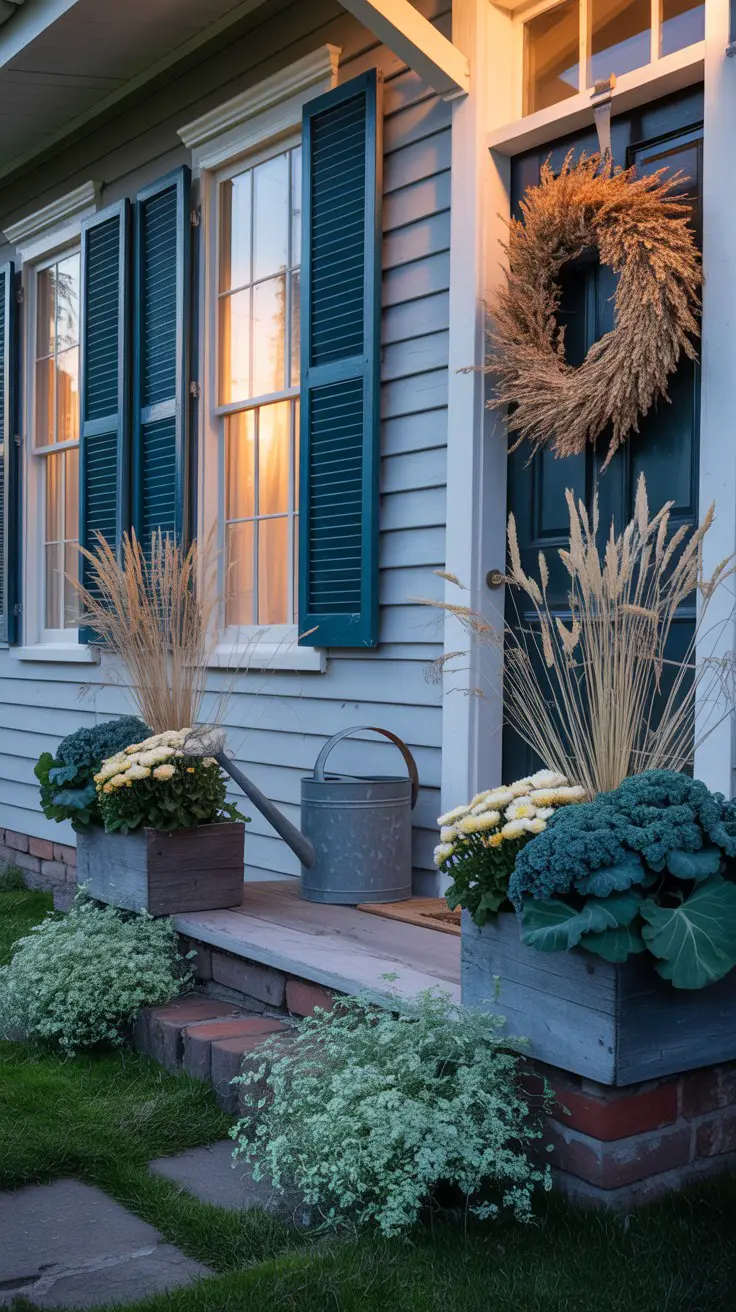
Your Autumn Welcome Awaits
You’ve got the tools. A clear plan turns simple pots into a warm hello. And your porch can feel personal, not cookie-cutter.
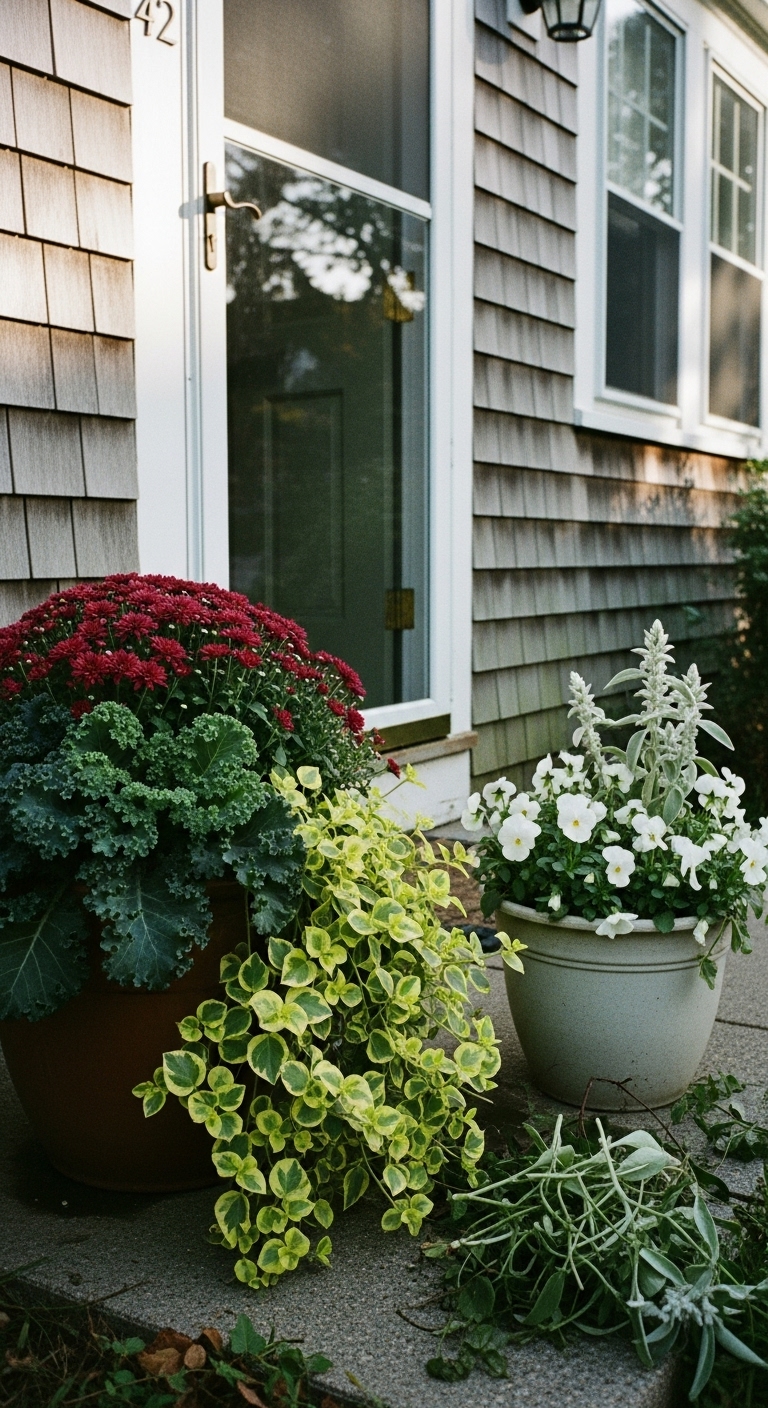
Key Takeaways
- Start with the fall ethos: harvest, warmth, and sturdy beauty that lasts.
- Use the triangle method: tall thriller, rounded filler, trailing spiller.
- Build a tight color story. Let texture do the heavy lifting.
- Match sun lovers to bright spots and shade stars to covered areas.
- Mix real plants with good faux and simple found bits for easy charm.
- Style the entry with balance, symmetry or asymmetry, smart scale, gentle light, and harmony with the house.

Start the Process
Pick a palette tonight. Gather one tall element, two mounding plants, and one trailer. Add a branch, a pinecone, or a pumpkin for fun. Set your pots where the light suits them. Water well. Tweak once a week. And enjoy that small daily moment at the door. Guests will feel it too.
